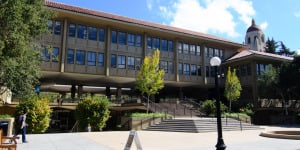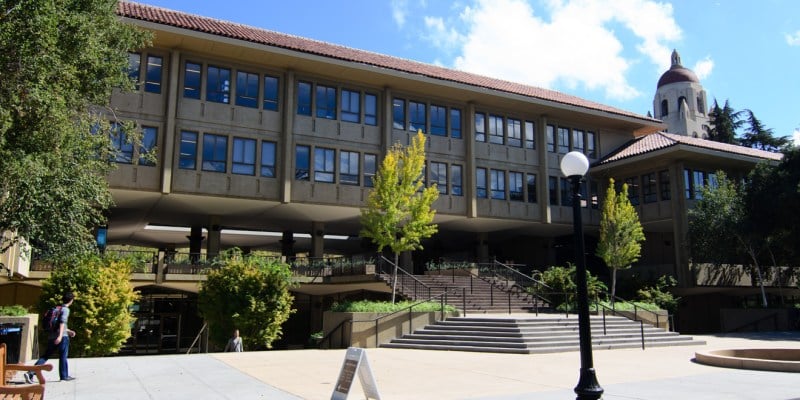
While Lathrop Library is mostly praised by the Stanford community for its new resources — including a high-tech sound system and multiple screens in one of its larger rooms — its 24-hour study room, although featuring heightened security, is less lauded by students, in part because of its small size and lack of abundant desk space.
New classroom and facility technological installations
Room 282 in Lathrop features a high-tech sound system called Constellation, which utilizes 40 hanging microphones and 76 speakers placed throughout the 3,000-square-foot room to control the room’s acoustics.
This system was produced by Meyer Sound, a company from Berkeley, and costs around $350,000, according to Bob Smith, director of technology services at the Office of the Registrar.
Smith explained that by selecting certain modes, including “small group mode” or “question and answer mode,” the microphone configuration can be customized to synchronize with the lecture format, Q&A sessions or classroom discussions.
“A few other universities use this system in concert halls, but this is the first time it’s been applied in a classroom setting,” Smith said.
Susan McConnell, professor of the biology department, began teaching her class Bio158: Developmental Neurobiology in room 282 this fall. Having originally taught the class in a traditional lecture-hall setting, she was pleased with the features of the room’s new sound system.
“If someone in the back corner of the room wants to answer a question or offer an idea, that person can speak in a normal voice, and I can hear her and so can everyone,” McConnell said.
Rather than sitting in rows of chairs, the 110 students who attend McConnell’s class are able to sit at tables, which McConnell noted is much more conducive to conversation.
“It’s more collaborative, [and] it’s more open to letting students’ ideas come up, and less about just delivering content,” McConnell said.
Furthermore, there are 80-inch, 3D-capable screens placed around the room that allow students sitting at any location to have a good view of the digital presentations.
Student criticism of the 24-hour study space
Lathrop’s 24-hour study room is only accessible with Stanford IDs during after-hours, unlike Meyer which had been open to anyone at all hours.
According to Gabrielle Karampelas, director of communications and development for Stanford Libraries, security was an issue in the old 24-hour study room at Meyer because it was open to anyone, a compelling reason for requiring card key access in the new space.
“First and foremost our concern was…security and safety,” Karampelas said. “Now, you do need a Stanford ID to access the space.”
Though the 24-hour study room at Lathrop may have greater security, students have admitted dissatisfaction over the study space and in particular, students were surprised to find that this space was much smaller than its predecessor in Meyer.
“It’s nice…if you can find a seat,” said Sagar Saxena, a second-year masters student in mechanical engineering. “A lot of times I come in there and there’s nowhere to sit so I have to go find another place.”
Lack of space could become a serious issue during high-traffic periods, like midterms and finals week, when students typically need quiet study places at very early or late hours.
One of the larger complaints, however, is that the majority of the study spaces in the 24-hour study room consist of small desks of which desktop computers occupy a large surface area. The few larger worktables at the edge of the study room that offer more desk space are often occupied quickly by students.
MacKenzie Alexis Yaryura ’17 said that adding more worktables without computers would improve the space.
“If you’re just going to bring a book and do reading, it’s easy to get distracted by technology,” Yaryura said.
Another possible inconvenience is that there are no bathrooms directly accessible in the 24-hour study room. Students who wish to use the bathroom must go outside and use their IDs to enter other buildings with restrooms.
“It took me a while to figure out that the bathroom is in the other building,” Saxena said.
Further additions to Lathrop
Karampelas also revealed plans for a café to be built on the floor below the 24-hour study room, which many students are excited about.
“We are in the RFP (request for proposal) process for a café that would be on the basement level…underneath the 24-hour study space,” Karampelas said. “We are going out to various vendors and seeing what their proposals are for that space.”
However, Karampelas noted that an eatery in the space would likely not be open until next year.
Contact Erica Evans at elevans ‘at’ stanford.edu.
